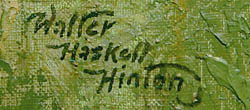

Homepage
![]()
A major campaign
Walter Haskell Hinton and the Washington National Insurance Company enjoyed a business relationship that lasted about 35 years, beginning in the late 1920s. During that time Hinton produced around 25 large paintings of episodes in the life of George Washington. With these images, the insurance company first produced calendars, and later, educational packages that were distributed for many years to schoolchildren to teach them about Washington and the American Revolution. The series also appeared in a television broadcast in 1975, which reached 80 million people.
Hinton had been sent along to Washington National by the calendar firm of Brown & Bigelow, who hoped the company would order promotional calendars. Hinton's aptitude for history painting combined with his knowledge of the 18th century happened to fit plans that the corporation already had underway to commission paintings of George Washington's life. Hinton solved a dilemma they were having: all the paintings they already had commissioned from other artists focused on military themes, but they wanted non-miltary subjects since public sentiment at that time was not sympathetic to war. Right there in the office, Hinton began sketching out pictures of Washington in his daily life as a family man and young professional, and he won the contract. From then on, Hinton usually came up with the scenes on his own and proposed them to the Company. He was careful to paint only episodes that actually happened, so the story of young George cutting down a cherry tree, known to be a myth, is not included. Washington is seen going about his daily life as a surveyor, stepfather, brother, general and statesman.
A main challenge was keeping Washington’s likeness consistent not just from panel to panel, but with popular portraits of him as well. He had to be recognizable to children. As a result, Washington looks rather wooden and expressionless in the series. The repetition of this stoic, ennobled Washington helped instill him as a national icon for students.



In this sketch, Washington carves his name on a bridge. Hinton did not take the idea to completion, however, because he worried people might be encouraged to commit vandalism by it.

Biography

Outdoors magazines

Pulps & Westerns

Farm magazines

John Deere

Fairmont Railways

Washington Nat'l Ins.

Advertising

Native Americans

Calendars & prints

Puzzles


